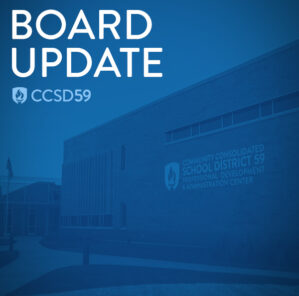Timeline of Events – Administration Center and Bond Issuance
Cronología de Eventos - Centro de Administración y Emisión de Bonos
In August of 2012, the Wellington restaurant next to the current CCSD59 administration center closed. The building and associated land was listed for sale, and there was little interest in the property by potential buyers. In the late fall, the district began discussions regarding the potential purchase of the property.
The district held a reciprocal agreement with the Wellington to share parking as the administration center property didn’t have enough parking available to accommodate meetings or professional development that take place during the day.
In July of 2013, the district purchased the Wellington lot for $1.8 million which was well under market value. The purchase provided the district with the needed parking as well as the opportunity to consider the property for possible use for updating the administration center.
In March of 2014, the district facility committee conducted an evaluation to determine potential long term use options for the Wellington lot, and the board began discussions about the needs for renovating or rebuilding the current administration center. Of the district’s 15 buildings, the administration center is the only building which has not been renovated over the past 33 years. The current administration center is not conducive for future professional development and meeting space needs.
In November of 2015, the board discussed three potential options for renovating or rebuilding an administration center. The options included renovating the current building, building a new administration center on the Wellington lot and selling a portion of the current administration center property, or selling both the current administration center lot and the Wellington lot and building on the seven acre, district-owned property in Elk Grove Village where Lively Junior High School had been previously located.
In December of 2015, the board hosted two community listening and information sessions to discuss the three options. A survey was developed and administered to the community and CCSD59 staff to gather feedback regarding the three options. The responses from the community and staff for all three options were similar with no single option emerging as the clear favorite.
The district investigated the possibility of building the new administration center at an alternative property, including the possibility of building in the Elk Grove Village industrial park, but the investigation found the district would have to purchase property which would incur additional expense for the project and take a taxing entity off the tax rolls.
In February of 2016, the board approved the plan to build a new 40,000 square foot administration center at 999 Leicester Road in Elk Grove Village at an initial estimated cost of $12 million.
The approved plan and design, after completion of the administration center, would allow for the park district to use the remaining portion of the field for two soccer fields if they choose. Patrons at Pirate’s Cove would also continue to be allowed to use available district parking. The plan also allows for local residents to continue to use the land for activities such as taking daily walks.
The sale of the current administration center property and the former Wellington lot would also allow those properties to potentially return back on the tax rolls to benefit the community.
As part of the plan, the district also conducted a traffic study from an independent agency, which found there would not be a significant impact on local traffic, and the only increase in neighborhood traffic anticipated would be minimal from employees who live in the neighborhood.
In May of 2016, the board began discussions considering adding a commissary kitchen to the new administration center property. This was caused by the food vendor terminating their food service contract before the end of the school year due to lost revenue from transporting food from their out of district site. Having a district-owned commissary kitchen would result in reduced costs for student meals through the bidding process.
In June of 2016, the board approved the sale of the former Wellington property and the current administration center property at a sale price of $5 million.
In February of 2017, the construction bid process was completed and an increase in construction costs from the time of initial building evaluation resulted in a 25% increase in building costs.
In March of 2017, the board approved the award of contracts for the administration building and commissary for $13,939,413 including contingency. This was only the bid contracts and does not include legal and architectural fees, staff time, etc. The total estimated cost for the project is $17,181,191.
Over the past several months, a number of financial challenges have increased the uncertainty for the district’s financial position. Financial challenges the district must consider include, but are not limited to:
- Providing the resources needed to best meet the needs of our students who come to us with educational, emotional and language deficits
- Uncertain state and federal funding
- Legislation negatively impacting the financial health of the school district
- Tax cap freeze
- Pension cost shifts
- School funding reform
- Rising costs of health insurance
- Rising costs of construction
In May of 2017, the board was presented the option to consider the possibility of issuing debt in the form of bonds not to exceed $20 million. The issuance of the bonds would improve the district’s stability and allow for necessary time for the district to balance the budget and strategically deficit spend from the district’s reserves. The bonds would be used to pay for a portion of the administration center, renovations at Devonshire School and Friendship Junior High School, and capital projects across the district such as updating school roofing.
The issuance of $20 million in bonds would result in an approximate annual property tax increase of $19.90 for a house valued at $250,000. The issuance of $15 million in bonds would result in an approximate annual property tax increase of $14.95 for a house valued at $250,000. The issuance of $10 million in bonds would result in an approximate annual property tax increase of $10.01 for a house valued at $250,000.
Once the bonds are paid back, property tax levels would be reduced by the increase resulting from the bonds. Residents would see the decrease in 2025 for $20 million in bonds, the decrease in 2024 for $15 million in bonds, and 2023 for $10 million in bonds.
The district currently maintains a fund balance of $110,747,601, and while the board will strategically deficit spend into the reserves this year, the issuance of the bonds will ensure financial stability, the continuation of programs to best support students, and protect against the financial uncertainty at the state and federal levels. The bonds can not be used for staff salaries and will not be used to increase district personnel.
At this point in the timeline, the option to discontinue the building of the administration center would result in the district incurring costs to negotiate or litigate out of the construction contracts. With design costs already paid for, attempting to discontinue the building of the new administration center may result in estimated costs over $5 million. The district would also need to attempt to terminate the sales contract for the existing properties already sold.
If bonds are not issued to offset a portion of the cost for the administration center, the project would continue forward, but would do so being funded entirely from district reserves, which would result in additional financial instability.
En agosto del 2012, el restaurante Wellington junto al actual centro de administración CCSD59 fue cerrado. El edificio y la tierra asociada estaba lista para la venta y había poco interés en la propiedad por los compradores potenciales. A finales del otoño, el distrito comenzó discusiones sobre la compra potencial de la propiedad.
El distrito celebró un acuerdo recíproco con el Wellington para compartir el estacionamiento ya que la propiedad del centro administrativo no tenía suficiente estacionamiento disponible para acomodar reuniones o desarrollo profesional que ocurrían durante el día.
En julio de 2013, el distrito compró el terreno de Wellington por 1.8 millones de dólares, que estaba muy por debajo del valor de mercado y la compra proporcionó al distrito el estacionamiento necesario, así como la oportunidad de considerar la propiedad para la actualización del centro administrativo.
En marzo de 2014, el comité de instalaciones del distrito llevó a cabo una evaluación para determinar posibles opciones de uso a largo plazo para el terreno de Wellington y la junta comenzó discusiones sobre las necesidades de renovación o reconstrucción del actual centro administrativo. De los 15 edificios del distrito, el centro administrativo es el único edificio que no ha sido renovado durante los últimos 33 años. El actual centro de administración no es propicio para el desarrollo profesional futuro y las necesidades de espacio de reunión.
En noviembre de 2015, la junta discutió tres posibles opciones para renovar o reconstruir un centro administrativo. Las opciones incluyeron la renovación del edificio actual, la construcción de un nuevo centro de administración en el terreno de Wellington y la venta de una parte de la propiedad del centro de administración actual, o la venta del lote del centro administración actual y el terreno Wellington y la construcción de los siete acres, propiedad en Elk Grove Village, donde la Escuela Presecundaria Lively había sido previamente localizada.
En diciembre de 2015, la junta organizó dos sesiones de escucha e información de la comunidad para discutir las tres opciones. Se desarrolló una encuesta y se administró a la comunidad y al personal de CCSD59 para recopilar información sobre las tres opciones. Las respuestas de la comunidad y el personal para las tres opciones fueron similares, sin ninguna opción emergiendo como el favorito.
El distrito investigó la posibilidad de construir el nuevo centro de administración en una propiedad alternativa, incluyendo la posibilidad de construir en el parque industrial de Elk Grove Village, pero la investigación encontró que el distrito tendría que comprar propiedades que incurrirán en gastos adicionales para el proyecto y tomarían una entidad tributaria fuera de los rollos de impuestos.
En febrero de 2016, la junta aprobó el plan para construir un nuevo centro de administración de 40,000 pies cuadrados en 999 Leicester Road en Elk Grove Village a un costo inicial estimado de $12 millones.
El plan aprobado y el diseño, después de la finalización del centro de administración, permitiría que el distrito del parque utilice la porción restante del campo para dos campos de fútbol si así lo desean. Los patrocinadores en Pirate’s Cove también continuarán permitiendo utilizar el estacionamiento disponible del distrito. El plan también permite que los residentes locales continúen usando la tierra para actividades tales como paseos diarios.
La venta de la propiedad del centro de administración actual y el antiguo lote de Wellington también permitiría que esas propiedades potencialmente regresen a los rollos de impuestos para beneficiar a la comunidad.
Como parte del plan, el distrito también llevó a cabo un estudio de tráfico de una agencia independiente, que encontró que no habría un impacto significativo en el tráfico local y el único aumento en el tráfico de vecindad previsto sería mínimo de los empleados que viven en el vecindario.
En mayo de 2016, la junta comenzó discusiones considerando agregar una cocina de comisario a la nueva propiedad del centro de administración. Esto fue causado por el proveedor de alimentos que termina su contrato de servicio de alimentos antes del final del año escolar debido a la pérdida de ingresos por el transporte de alimentos de su sitio fuera del distrito. Tener una cocina de comisario de propiedad del distrito resultaría en costos reducidos para las comidas del estudiante a través del proceso de licitación.
En junio de 2016, la junta aprobó la venta de la antigua propiedad de Wellington y la propiedad del centro de administración actual a un precio de venta de $5 millones.
En febrero de 2017, se completó el proceso de licitación de la construcción y un aumento en los costos de construcción desde el momento de la evaluación inicial del edificio resultó en un aumento de 25% en los costos de construcción.
En marzo de 2017, la junta aprobó la adjudicación de contratos para el edificio de la administración y el comisario por $13,939,413 incluyendo contingencia. Éste era solamente los contratos de la oferta y no incluye honorarios legales y arquitectónicos, tiempo del personal, etc. El coste total estimado para el proyecto es $17,181,191.
Durante los últimos meses, una serie de desafíos financieros han aumentado la incertidumbre para la situación financiera del distrito. Los desafíos financieros que el distrito debe considerar incluyen, pero no se limitan a:
- Proporcionar los recursos necesarios para satisfacer mejor las necesidades de nuestros estudiantes que vienen a nosotros con déficits educativos, emocionales y de lenguaje
- Financiamiento estatal y federal incierto
- Legislación que afecta negativamente la salud financiera del distrito escolar
- Congelación de la tapa del impuesto
- Cambios en el costo de la pensión
- Reforma de la financiación escolar
- Aumento de los costos de la aseguranza de salud
- Aumento de los costos de construcción
En mayo de 2017, se presentó la opción de considerar la posibilidad de emitir deuda en forma de bonos que no excedan los $20 millones. La emisión de los bonos mejoraría la estabilidad del distrito y permitiría el tiempo necesario para que el distrito equilibre el presupuesto y el gasto estratégicamente deficitario de las reservas del distrito. Los bonos se utilizarían para pagar una parte del centro administrativo, las renovaciones en la Escuela Devonshire y la Escuela Presecundaria Friendship y proyectos de capital en todo el distrito, tales como la actualización del techo de la escuela.
La emisión de $20 millones en bonos daría lugar a un aumento anual aproximado del impuesto predial de $19.90 para una casa valorada en $250,000. La emisión de $15 millones en bonos daría lugar a un aumento anual aproximado del impuesto a la propiedad de $14.95 para una casa valorada en $250,000. La emisión de $10 millones en bonos daría lugar a un aumento anual aproximado del impuesto sobre la propiedad de $10.01 dólares para una casa valorada en $250,000 dólares.
Una vez que se devuelvan los bonos, los niveles de los impuestos sobre la propiedad se reducirán por el aumento resultante de los bonos. Los residentes verían la disminución en 2025 por $20 millones en bonos, la disminución en 2024 por $15 millones en bonos y 2023 por $10 millones en bonos.
Actualmente, el distrito mantiene un saldo de $110,747,601 y mientras que la Junta invertirá el déficit estratégico en las reservas este año, la emisión de los bonos garantizará la estabilidad financiera, la continuación de los programas para apoyar mejor a los estudiantes y proteger contra la incertidumbre financiera en los niveles estatal y federal. Los bonos no pueden utilizarse para los sueldos del personal y no se utilizarán para aumentar el personal del distrito.
En este punto de la línea de tiempo, la opción de discontinuar la construcción del centro de administración tendría como resultado que el distrito incurriera en costos para negociar o litigar fuera de los contratos de construcción. Con los costos de diseño ya pagados, el intento de discontinuar la construcción del nuevo centro administrativo puede resultar en costos estimados de más de $5 millones. El distrito también tendría que intentar terminar el contrato de venta de las propiedades existentes ya vendidas.
Si no se emiten bonos para compensar una parte del costo del centro administrativo, el proyecto seguiría adelante, pero lo haría financiado totalmente con las reservas distritales, lo que resultaría en una inestabilidad financiera adicional.
La junta continuará teniendo discusiones y evaluará la opción de emitir bonos en la reunión de la junta de educación del 14 de agosto de 2017.



